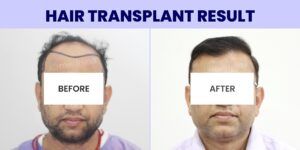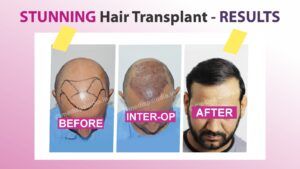
Every person, whether they are female or male, should be concerned about hair loss since it may be a traumatic experience. Uncontrolled hair loss has the potential to have a negative psychological influence over time, as well as damage mental health. In the modern world, where personality increasingly outweighs knowledge in professional careers, it is crucial to excel in all areas, including appearance. Hence, aesthetic issues like hair loss not only make people feel embarrassed in public, but also interfere with their ability to work.
Male pattern baldness:
Male pattern baldness, also known as androgenic alopecia, is a kind of genetically based irreversible hair loss. The worst aspect is that male pattern baldness can’t be stopped and has an unpredictable course of progression. The use of hot tools (Hair straightener, Hair curler), hot baths, stress, chemical straightening, tight braiding, postmenopausal hormonal change, medications (anti-depressants, anti-anxiety, and anti-psychotics), lack of sleep, and poor nutrition are some of the factors that contribute to the progression of hair loss.
What are the treatment options for pattern baldness?
If you’re looking for treatment alternatives for pattern baldness, a kind of baldness that is irreversible, you should know that there is currently no medication that can replace lost hair follicles. Nevertheless, there are a few therapeutic options that can either stop hair loss in its tracks or halt its progression by regrowing damaged hair follicles. They include:
- Temporary aids: Wigs, extensions, or synthetic hair are common first steps people take when dealing with a hair loss issue. But do you believe you could use them indefinitely? Absolutely not! Because these modalities require frequent replacement and heavy maintenance, they are only practical for short-term use because they might be exceedingly taxing and expensive over the long run.
- Drugs: Minoxidil and finasteride are two drugs that may be purchased on the market to treat hair loss. These drugs work by reducing the pace of hair loss or by speeding up the development of new hair. These drugs work, although possibly for a shorter period of time because your hair growth may resume after you stop using them. Long-term use of the medicine, like all medications, may have certain negative effects.
- PRP therapy: PRP therapy is recommended in cases of early hair loss and aims to stimulate hair growth in the targeted region. These days, it is a highly popular and successful therapeutic option, but only in situations of early hair loss.
- Hair transplant: The final surgical therapy option is hair transplant, the only long-term fix for your hair loss problem. The surgical procedure known as a hair transplant includes transferring hair grafts from the donor region to the target bald area. Although the technique for hair transplantation is voluntary, its viability is not always guaranteed. As the recovery from the surgery is rather quick, you don’t need to put your busy schedule at risk and may return to work the very following day.
Hair transplant: An effective treatment
Male pattern baldness patients who undergo hair transplantation benefit in a variety of ways, including:
- Improved appearance: Personality and appearance are now important assets in one’s life for increasing self-confidence and success in both social and professional situations. Successful hair transplantation results in a more natural appearance. The joy of discovering hairs on a bald head can only be understood by someone who is experiencing hair loss.
- Produces permanent results: The only form of therapy that produces permanent outcomes is hair transplantation. The hair follicles in the DHT-resistant zones are unaffected by hormonal changes and remain there permanently. The genetic makeup of the hairs is contained in the follicle itself, which when transplanted to another place adopts hair follicle features rather than scalp characteristics. As a consequence, the recipient’s bald region receives lasting effects from the transplanted hairs from the back and sides of the head.
- Long-term benefits: The hair transplant offers the choice of numerous sittings in situations of advanced hair loss and complete baldness. The preservation of hair follicles for future use is made possible by the FUT hair transplant procedure or a combination of the FUT and FUE techniques.
- Natural outcome: World-class natural outcomes are now achievable thanks to recent technological advancements. A skilled and experienced surgeon might provide a natural-looking outcome if the surgery is carried out. The most crucial element for a natural and invisible appearance is hairline design. To ensure an appealing result, the arrangement, alignment, and angulations of the follicular transplants should be meticulously planned.





